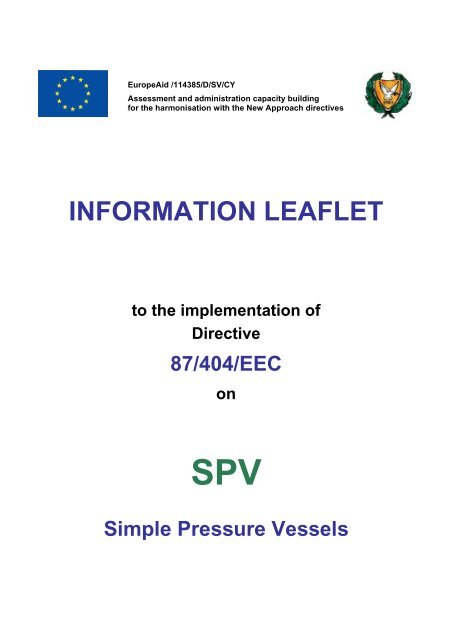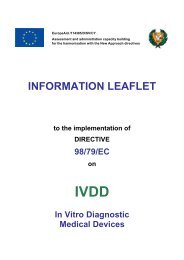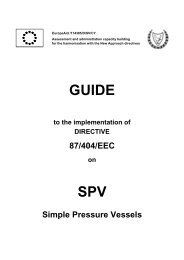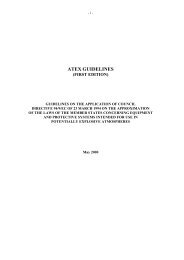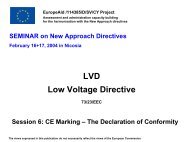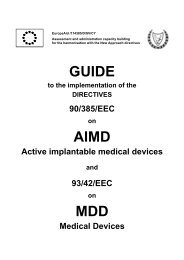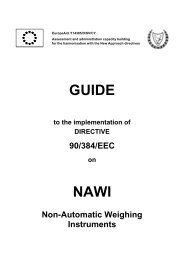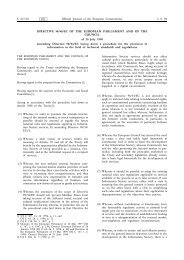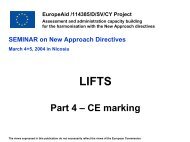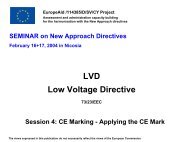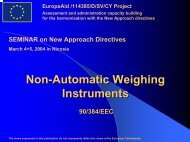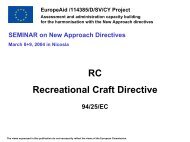information leaflet - Cyprus Organization for the Promotion of Quality
information leaflet - Cyprus Organization for the Promotion of Quality
information leaflet - Cyprus Organization for the Promotion of Quality
You also want an ePaper? Increase the reach of your titles
YUMPU automatically turns print PDFs into web optimized ePapers that Google loves.
EuropeAid /114385/D/SV/CYAssessment and administration capacity building<strong>for</strong> <strong>the</strong> harmonisation with <strong>the</strong> New Approach directivesINFORMATION LEAFLETto <strong>the</strong> implementation <strong>of</strong>Directive87/404/EEConSPVSimple Pressure Vessels
In<strong>for</strong>mation Leaflet on SPV DirectiveEuropeAid /114385/D/SV/CY5. Any vessel manufactured in con<strong>for</strong>mity with <strong>the</strong> harmonised standards is presumed to comply with <strong>the</strong>essential requirements.6. Procedures <strong>for</strong> <strong>the</strong> testing <strong>of</strong> vessels <strong>for</strong> con<strong>for</strong>mity with <strong>the</strong> essential requirements are based on <strong>the</strong>modular approach set out in Council Decision 93/465/EEC concerning con<strong>for</strong>mity assessmentprocedures and <strong>the</strong> affixing <strong>of</strong> <strong>the</strong> CE marking. Con<strong>for</strong>mity assessment is carried out:• ei<strong>the</strong>r by bodies designated by <strong>the</strong> Member States in accordance with common assessmentcriteria and communicated to <strong>the</strong> Commission and <strong>the</strong> o<strong>the</strong>r Member States;• or by <strong>the</strong> manufacturers <strong>the</strong>mselves.7. Be<strong>for</strong>e being placed on <strong>the</strong> market, vessels must bear <strong>the</strong> CE marking which:• indicates <strong>the</strong>ir con<strong>for</strong>mity with <strong>the</strong> provisions <strong>of</strong> <strong>the</strong> Directive;• consists <strong>of</strong> <strong>the</strong> distinctive "CE" initials;• is affixed by <strong>the</strong> manufacturer or his authorized representative in <strong>the</strong> Community.8. The vessel or data plate must bear, in addition to <strong>the</strong> CE marking, at least one <strong>of</strong> <strong>the</strong> seven additionalinscriptions described in <strong>the</strong> Directive.9. Where a vessel is <strong>the</strong> subject <strong>of</strong> o<strong>the</strong>r Directives, which require <strong>the</strong> CE marking, affixation <strong>of</strong> <strong>the</strong>marking also indicates that <strong>the</strong> vessel complies with <strong>the</strong> requirements <strong>of</strong> <strong>the</strong>se o<strong>the</strong>r Directives.10. Any o<strong>the</strong>r mark may be affixed on vessels, unless it risks being confused with <strong>the</strong> con<strong>for</strong>mity marking.11. Penalties are adopted by <strong>the</strong> Member States in cases where <strong>the</strong> latter establish that <strong>the</strong> CE markinghas been affixed unduly.AMENDING DIRECTIVE 90/488/EECThis Directive introduced a transitional period until 1 July 1992.AMENDING DIRECTIVE 93/68/EECThis Directive sets a transitional period from 1 January 1995 (date from which <strong>the</strong> Directive 93/68/EECenters into <strong>for</strong>ce) to 1 January 1997, during which <strong>the</strong> Member States shall authorize <strong>the</strong> placing on <strong>the</strong>market and/or putting into service <strong>of</strong> vessels, which comply with <strong>the</strong> regulations in <strong>for</strong>ce on <strong>the</strong>ir territorybe<strong>for</strong>e 1 January 1995.'Simple Pressure Vessel' (Article 1) means any welded vessel subjected to an internal gauge pressuregreater than 0,5 bar which is intended to contain air or nitrogen and which is not intended to be fired.REQUIREMENTS FOR THE VESSELS – SOUND ENGINEERING PRACTICE1. Vessels in respect <strong>of</strong> which <strong>the</strong> product <strong>of</strong> PS and V exceeds 50 bar.litre must satisfy <strong>the</strong> essentialsafety requirements set out in Annex I.2. Vessels in respect <strong>of</strong> which <strong>the</strong> product <strong>of</strong> PS and V is 50 bar.litre or less must be manufactured inaccordance with sound engineering practice in one <strong>of</strong> <strong>the</strong> Member States and bear markings as laiddown in Section 1 <strong>of</strong> Annex II, with <strong>the</strong> exception <strong>of</strong> <strong>the</strong> EC marking referred to in Article 16.CERTIFICATION PROCEDURES1. Prior to <strong>the</strong> production <strong>of</strong> simple pressure vessels <strong>of</strong> which <strong>the</strong> product <strong>of</strong> PS and V exceeds 50bar.litre, manufactured:(a) in accordance with <strong>the</strong> standards referred to in Article 5(1), <strong>the</strong> manufacturer, or his authorizedrepresentative established within <strong>the</strong> Community, shall at his own choice:• ei<strong>the</strong>r in<strong>for</strong>m an approved Inspection Body as referred to in Article 9, which after examining<strong>the</strong> design and manufacturing schedule referred to in paragraph 3 <strong>of</strong> Annex II, shall draw upa Certificate <strong>of</strong> Adequacy attesting that <strong>the</strong> schedule is satisfactory, or• submit a prototype vessel <strong>for</strong> <strong>the</strong> EC type - examination referred to in Article 10;
In<strong>for</strong>mation Leaflet on SPV DirectiveEuropeAid /114385/D/SV/CY(b) not, or only partly, in accordance with <strong>the</strong> standards referred to in Article 5(1), <strong>the</strong> manufacturer, orhis authorized representative established within <strong>the</strong> Community, must submit a prototype vessel<strong>for</strong> <strong>the</strong> EC type-examination referred to in Article 10.2. Vessels manufactured in accordance with <strong>the</strong> standards referred to in Article 5(1) or with <strong>the</strong> approvedprototype shall, prior to <strong>the</strong>ir being placed on <strong>the</strong> market, be subject:• to <strong>the</strong> EC Verification referred to in Article 11 where <strong>the</strong> product <strong>of</strong> PS and V exceeds 3000bar.litre:At <strong>the</strong> choice <strong>of</strong> <strong>the</strong> manufacturer, where <strong>the</strong> product <strong>of</strong> PS and V does not exceed 3000 bar.litre butexceeds 50 bar.litre:• ei<strong>the</strong>r to <strong>the</strong> EC Declaration <strong>of</strong> Con<strong>for</strong>mity referred to in Article 12, or• to <strong>the</strong> EC Verification referred to in Article 11.3. The records and correspondence relating to <strong>the</strong> certification procedures referred to in aboveparagraphs 1 and 2 shall be drafted in an <strong>of</strong>ficial language <strong>of</strong> <strong>the</strong> Member State in which <strong>the</strong> approvedbody is established or in a language accepted by that body.4. Each Member State shall notify <strong>the</strong> Commission and <strong>the</strong> o<strong>the</strong>r Member States <strong>of</strong> <strong>the</strong> approved bodiesresponsible <strong>for</strong> carrying out <strong>the</strong> certification procedures referred to in Article 8(1) and 8(2). TheCommission shall publish a list <strong>of</strong> <strong>the</strong>se bodies and <strong>the</strong> distinguishing number it has assigned to <strong>the</strong>m,<strong>for</strong> <strong>in<strong>for</strong>mation</strong> purposes, in <strong>the</strong> Official Journal <strong>of</strong> <strong>the</strong> European Communities and shall ensure that<strong>the</strong> list is kept up to date.5. Annex III sets out <strong>the</strong> minimum criteria, which Member States must meet as regards approval <strong>of</strong> <strong>the</strong>sebodies.6. A Member State, which has approved a body, must withdraw approval if it finds that <strong>the</strong> body nolonger meets <strong>the</strong> criteria listed in Annex III. It shall immediately in<strong>for</strong>m <strong>the</strong> Commission and <strong>the</strong> o<strong>the</strong>rMember States accordingly.7. EC type-examination is <strong>the</strong> procedure by which an approved Inspection Body ascertains and certifiesthat a prototype vessel satisfies <strong>the</strong> provisions <strong>of</strong> this Directive, which apply to it.8. The application <strong>for</strong> EC type-examination shall be lodged by <strong>the</strong> manufacturer or by his authorizedrepresentative with a single approved Inspection Body in respect <strong>of</strong> a prototype vessel or <strong>of</strong> aprototype representing a family <strong>of</strong> vessels. That authorized representative must be established in <strong>the</strong>Community.The application shall include:• <strong>the</strong> name and address <strong>of</strong> <strong>the</strong> manufacturer or <strong>of</strong> his authorized representative and <strong>the</strong> place <strong>of</strong>manufacture <strong>of</strong> <strong>the</strong> vessels,• <strong>the</strong> design and manufacturing schedule referred to in paragraph 3 <strong>of</strong> Annex II. It shall beaccompanied by a vessel, which is representative <strong>of</strong> <strong>the</strong> production envisaged.9. The approved Inspection Body shall carry out <strong>the</strong> EC type-examination in <strong>the</strong> manner describedbelow. It shall examine not only <strong>the</strong> design and manufacturing schedule in order to check itscon<strong>for</strong>mity, but also <strong>the</strong> vessel submitted.When examining <strong>the</strong> vessel, <strong>the</strong> body shall:• verify that <strong>the</strong> vessel has been manufactured in con<strong>for</strong>mity with <strong>the</strong> design and manufacturingschedule and may safely be used under its intended working conditions;• per<strong>for</strong>m appropriate examinations and tests to check that <strong>the</strong> vessel complies with <strong>the</strong> essentialrequirements applicable to it.10. If <strong>the</strong> prototype complies with <strong>the</strong> provisions applicable to it <strong>the</strong> body shall draw up an EC typeexaminationCertificate, which shall be <strong>for</strong>warded to <strong>the</strong> applicant. That certificate shall state <strong>the</strong>conclusions <strong>of</strong> <strong>the</strong> examination, indicate any conditions to which its issue may be subject and beaccompanied by <strong>the</strong> descriptions and drawings necessary <strong>for</strong> identification <strong>of</strong> <strong>the</strong> approved prototype.
In<strong>for</strong>mation Leaflet on SPV DirectiveEuropeAid /114385/D/SV/CYThe Commission, <strong>the</strong> o<strong>the</strong>r approved bodies and <strong>the</strong> o<strong>the</strong>r Member States may obtain a copy <strong>of</strong> <strong>the</strong>certificate and, on a reasoned request, a copy <strong>of</strong> <strong>the</strong> design and manufacturing schedule and <strong>the</strong>reports on <strong>the</strong> examinations and tests carried out.11. A body, which refuses to issue an EC type-examination certificate, shall so in<strong>for</strong>m <strong>the</strong> o<strong>the</strong>r approvedbodies. A body, which withdraws an EC type-examination certificate, shall so in<strong>for</strong>m <strong>the</strong> Member Statewhich approved it. The latter shall in<strong>for</strong>m <strong>the</strong> o<strong>the</strong>r Member States and <strong>the</strong> Commission <strong>the</strong>re<strong>of</strong>, giving<strong>the</strong> reasons <strong>for</strong> <strong>the</strong> decision.EC VERIFICATION1. The purpose <strong>of</strong> EC Verification is to check and certify that series-manufactured vessels comply with<strong>the</strong> standards referred to in Article 5(1) or with <strong>the</strong> approved prototype. It shall be per<strong>for</strong>med by anapproved Inspection Body in accordance with <strong>the</strong> provisions set out below. That body shall issue anEC Verification Certificate and affix <strong>the</strong> mark <strong>of</strong> con<strong>for</strong>mity provided <strong>for</strong> in Article 16.2. Verification shall be per<strong>for</strong>med on <strong>the</strong> batches <strong>of</strong> vessels submitted by <strong>the</strong>ir manufacturer or by hisauthorized representative established within <strong>the</strong> Community. Batches shall be accompanied by <strong>the</strong>EC type-examination certificate referred to in Article 10, or, if <strong>the</strong> vessels are not manufactured inaccordance with an approved prototype, by <strong>the</strong> design and manufacturing schedule referred to inAnnex II section 3. In <strong>the</strong> latter case <strong>the</strong> approved Inspection Body shall, prior to EC Verification,examine <strong>the</strong> schedule in order to certify its con<strong>for</strong>mity.3. When a batch is examined, <strong>the</strong> approved Inspection Body shall ensure that <strong>the</strong> vessels have beenmanufactured and checked in accordance with <strong>the</strong> design and manufacturing schedule and shallper<strong>for</strong>m a hydrostatic test or, a pneumatic test <strong>of</strong> equivalent effect on each vessel in <strong>the</strong> batch at apressure Ph equal to 1,5 times <strong>the</strong> vessel's design pressure in order to check its soundness. Thepremature test shall be subject to acceptance <strong>of</strong> <strong>the</strong> test safety procedures by <strong>the</strong> Member States inwhich <strong>the</strong> test is per<strong>for</strong>med. Moreover, <strong>the</strong> approved Inspection Body shall carry out tests on testpiecestaken from a representative production test-piece or from a vessel, as <strong>the</strong> manufacturerchooses in order to examine weld quality. The tests shall be carried out on longitudinal welds.However, where differing welding techniques are used <strong>for</strong> longitudinal and circular welds, <strong>the</strong> testsshall be repeated on <strong>the</strong> circular welds.4. For <strong>the</strong> vessels referred to in Section 2.1.2 <strong>of</strong> Annex I, <strong>the</strong>se tests on test-pieces shall be replaced bya hydrostatic test on five vessels taken at random from each batch, in order to check that <strong>the</strong>ycon<strong>for</strong>m to <strong>the</strong> requirements <strong>of</strong> Section 2.1.2 <strong>of</strong> Annex I.EC DECLARATION OF CONFORMITY1. A manufacturer fulfilling <strong>the</strong> obligations arising out <strong>of</strong> Article 13 shall affix <strong>the</strong> EC marking provided <strong>for</strong>in Article 16 to vessels, which he declares to be in con<strong>for</strong>mity with <strong>the</strong> standards, referred to in Article5 (1) or with an approved prototype. By this EC Declaration <strong>of</strong> Con<strong>for</strong>mity procedure <strong>the</strong> manufacturerbecomes subject to EC Surveillance, in cases where <strong>the</strong> product <strong>of</strong> PS and V exceeds 200 bar.litre.2. The purpose <strong>of</strong> EC Surveillance is to ensure, as required by Article 14(2), that <strong>the</strong> manufacturer dulyfulfil <strong>the</strong> obligations arising out <strong>of</strong> Article 13(2). Surveillance shall be per<strong>for</strong>med by <strong>the</strong> approvedInspection Body which issued <strong>the</strong> EC type-examination Certificate referred to in Article 10 where <strong>the</strong>vessels have been manufactured in accordance with an approved prototype or, if this is not <strong>the</strong> case,by <strong>the</strong> approved Inspection Body to which <strong>the</strong> design and manufacturing schedule was sent inaccordance with Article 8(1)(a), first indent.The EC type-examination Certificate, or <strong>the</strong> certificate <strong>of</strong> adequacy, is a document that describes <strong>the</strong>manufacturing processes and all <strong>of</strong> <strong>the</strong> pre-determined systematic measures taken to ensure con<strong>for</strong>mity<strong>of</strong> <strong>the</strong> pressure vessels to <strong>the</strong> standards referred to in Article 5(1) or <strong>the</strong> approved prototype.This document shall include:• a description <strong>of</strong> <strong>the</strong> means <strong>of</strong> manufacture and checking appropriate to <strong>the</strong> construction <strong>of</strong> <strong>the</strong>vessels:
In<strong>for</strong>mation Leaflet on SPV DirectiveEuropeAid /114385/D/SV/CY• an inspection document describing <strong>the</strong> appropriate examinations and tests to be carried out duringmanufacture, toge<strong>the</strong>r with <strong>the</strong> procedures and <strong>the</strong> frequency with which <strong>the</strong>y are to be per<strong>for</strong>med;• an undertaking to carry out <strong>the</strong> examinations and tests in accordance with <strong>the</strong> inspectiondocument referred to above and to have a hydrostatic test or, subject to <strong>the</strong> agreement <strong>of</strong> <strong>the</strong>Member State, a pneumatic test carried out on each vessel manufactured at a test pressure equalto 1,5 times <strong>the</strong> design pressure.• These examinations and tests shall be carried out under <strong>the</strong> responsibility <strong>of</strong> qualified staff whoare sufficiently independent from production personnel, and shall be covered by a report;• <strong>the</strong> addresses <strong>of</strong> <strong>the</strong> places <strong>of</strong> manufacture and storage and <strong>the</strong> date on which manufacture is tocommence.In addition, when <strong>the</strong> product <strong>of</strong> PS and V exceeds 200 bar.litre, manufacturers shall authorize access to<strong>the</strong> said places <strong>of</strong> manufacture and storage by <strong>the</strong> body responsible <strong>for</strong> EC Surveillance, <strong>for</strong> inspectionpurposes, and shall allow that body to select sample vessels and shall provide it with all necessary<strong>in<strong>for</strong>mation</strong>, and in particular:• <strong>the</strong> design and manufacturing schedule,• <strong>the</strong> inspection report,• <strong>the</strong> EC type-examination Certificate, or Certificate <strong>of</strong> Adequacy, where appropriate,• a report on <strong>the</strong> examinations and tests carried out.The approved Inspection Body which issued <strong>the</strong> EC type-examination Certificate, or Certificate <strong>of</strong>Adequacy, must, be<strong>for</strong>e <strong>the</strong> date on which any manufacture begins, examine both <strong>the</strong> document referredto in Article 13(1) and <strong>the</strong> design and manufacturing schedule referred to in Annex II, Section 3, in order tocertify <strong>the</strong>ir con<strong>for</strong>mity where vessels are not manufactured in accordance with an approved prototype.In addition, where <strong>the</strong> product <strong>of</strong> PS and V exceeds 200 bar.litre, that body must during manufacture:• ensure that <strong>the</strong> manufacturer actually checks series-produced vessels.• take random samples at <strong>the</strong> places <strong>of</strong> manufacture or at <strong>the</strong> place <strong>of</strong> storage <strong>of</strong> vessels <strong>for</strong>inspection purposes. The body shall supply <strong>the</strong> Member State, which approved it, and, on request,<strong>the</strong> o<strong>the</strong>r approved bodies, <strong>the</strong> o<strong>the</strong>r Member States and <strong>the</strong> Commission, with a copy <strong>of</strong> <strong>the</strong>inspection report.CHAPTER III is referring to EC markingCHAPTER IV contains Final provisionsANNEX IInclude <strong>the</strong> essential safety requirements <strong>for</strong> <strong>the</strong> vessels as set out below:MATERIALSMaterials must be selected according to <strong>the</strong> intended use <strong>of</strong> <strong>the</strong> vessels and in accordance with Section1.1 to Section 1.4.1.1.PRESSURIZED PARTSThe materials referred to in Article 1 used <strong>for</strong> manufacturing <strong>the</strong> pressurized parts must be:• capable <strong>of</strong> being welded,• ductile and-tough, so that a rupture at minimum working temperature does not give rise to ei<strong>the</strong>rfragmentation or brittle-type fracture,• not adversely affected by ageing.For steel vessels, <strong>the</strong> materials must in addition meet <strong>the</strong> requirements set out in Section 1.1.1 and, <strong>for</strong>aluminium or aluminium alloy vessels, those set out in Section 1.1.2.They must be accompanied by an Inspection Report drawn up by <strong>the</strong> producer <strong>of</strong> <strong>the</strong> materials asdescribed in Annex II.
In<strong>for</strong>mation Leaflet on SPV DirectiveEuropeAid /114385/D/SV/CY1.1.1. Steel vesselsNon-alloy quality steels must meet <strong>the</strong> following requirements:• <strong>the</strong>y must be non-effervescent and be supplied after normalization treatment, or in an equivalentstate;• <strong>the</strong> content per product <strong>of</strong> carbon must be less than 0,25 % and that <strong>of</strong> sulphur and phosphorusmust each be less than 0,05 %; and• <strong>the</strong>y must have specific mechanical properties per product.Summary list <strong>of</strong> titles and references <strong>of</strong> harmonised standards under Directive 87/404/EEC relatedto Simple Pressure VesselsStandardreferenceTitleEN 286-1 Simple unfired pressure vessels designed to contain air or nitrogen: Part 1:pressure vessels <strong>for</strong> general purposesThe presumption <strong>of</strong> con<strong>for</strong>mity, conferred by standard EN 286-1 <strong>of</strong> 1991published in <strong>the</strong> OJ C 104 <strong>of</strong> 1992-04-24, ends on 1998-08-31.EN 286-2EN 286-3EN 286-4EN 571-1EN 583-1Part 2: pressure vessels <strong>for</strong> air braking and auxiliary systems <strong>for</strong> motor vehiclesand <strong>the</strong>ir trailersPart 3: steel pressure vessels <strong>for</strong> air braking equipment auxiliary and pneumaticequipment <strong>for</strong> railway rolling stockPart 4: aluminium alloy pressure vessels <strong>for</strong> air braking equipment and auxiliarypneumatic equipment <strong>for</strong> railway rolling stockNon-destructive testing — Penetrant testing — Part 1: General principlesNon-destructive testing — Ultrasonic examination — Part 1: General principlesEN 1011-1 Welding — Recommendations <strong>for</strong> welding <strong>of</strong> metallic materials — Part 1:General guidance <strong>for</strong> arc weldingEN 1290EN 1330-3EN 1714EN 6520-1EN 12062Non-destructive examination <strong>of</strong> welds — Magnetic particle examination <strong>of</strong> weldsNon-destructive testing — Terminology — Part 3: Terms used in industrialradiographic testingNon-destructive examination <strong>of</strong> welds — Ultrasonic examination <strong>of</strong> welded jointsWelding and allied processes — Classification <strong>of</strong> geometric imperfections inmetallic materials — Part 1: Fusion welding (ISO 6520-1:1998)Non-destructive examination <strong>of</strong> welds — General rules <strong>for</strong> metallic materialsANNEX II include1. EC MARK AND INSCRIPTIONS2. INSTRUCTIONS3. DESIGN AND MANUFACTURING SCHEDULES4. DEFINITIONS AND SYMBOLS
In<strong>for</strong>mation Leaflet on SPV DirectiveEuropeAid /114385/D/SV/CYANNEX IIIInclude <strong>the</strong> minimum criteria to be taken into account by Member States, when appointing InspectionBodies.STANDARDSFur<strong>the</strong>r <strong>in<strong>for</strong>mation</strong> on standards and guidance <strong>in<strong>for</strong>mation</strong> can be obtained from <strong>the</strong> following bodies:<strong>Cyprus</strong> Organisation <strong>for</strong> <strong>the</strong> <strong>Promotion</strong> <strong>of</strong> <strong>Quality</strong>Ministry <strong>of</strong> Commerce, Industry and Tourism13-15, Andreas Araouzou Street, 1421 Nicosia, <strong>Cyprus</strong>http://www.cys.mcit.gov.cyCYPRUS COMPETENT AUTHORITYIn <strong>Cyprus</strong> <strong>the</strong> Ministry <strong>of</strong> Labour and Social Insurance, through <strong>the</strong> Department <strong>of</strong> Labour Inspection, isresponsible <strong>for</strong> en<strong>for</strong>cement <strong>of</strong> <strong>the</strong> Essential Requirements (Simple Pressure Vessels) Regulations <strong>of</strong>2003. Fur<strong>the</strong>r <strong>in<strong>for</strong>mation</strong> is available at <strong>Cyprus</strong> Contact as follows:Department <strong>of</strong> Labour InspectionMinistry <strong>of</strong> Labour and Social InsuranceContact:Marios KourtellisSenior Labour Inspection OfficerTel. 22 40 56 56Fax. 22 66 37 88mkourtellis@dli.mlsi.gov.cyCYPRUS LEGISLATIONGeneral requirements and stipulation are layed down in <strong>the</strong> <strong>Cyprus</strong> Framework Law N. 30(I)/2002(published 5.4.2002) as amended by N. 29(I)/2003 (published 28.3.2003). The Framework Law represents<strong>the</strong> legal basis <strong>for</strong> <strong>the</strong> <strong>Cyprus</strong> Regulations addressing respective Directives.The <strong>Cyprus</strong> Regulations addressing <strong>the</strong> Simple Pressure Vessel Directive is <strong>the</strong> Essential Requirements(Simple Pressure Vessels) Regulations <strong>of</strong> 2003, P.I. 312/2003 (published 18.4.2003).FURTHER INFORMATIONFur<strong>the</strong>r <strong>in<strong>for</strong>mation</strong> and links to all relevant European websites are available athttp://www.cys.mcit.gov.cyunder <strong>the</strong> button named:NEW APPROACHThis Leaflet was printed with funds <strong>of</strong> <strong>the</strong> EuropeAid /114385/D/SV/CY project:“Assessment and administration capacity building <strong>for</strong> <strong>the</strong> harmonisation with <strong>the</strong> New Approach directives”The views expressed in this publication do not necessarily reflect <strong>the</strong> views <strong>of</strong> <strong>the</strong> European Commissionor <strong>the</strong> Ministry <strong>of</strong> Commerce, Industry and Tourism or <strong>the</strong> Ministry <strong>of</strong> Labour and Social Insurance.© Republic <strong>of</strong> <strong>Cyprus</strong>, Nicosia, May 2004


